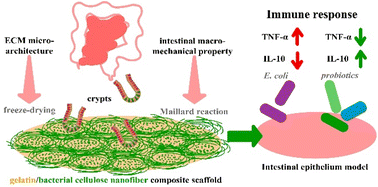Intestinal models based on biomimetic scaffolds with an ECM micro-architecture and intestinal macro-elasticity: close to intestinal tissue and immune response analysis†
Abstract
The synergetic biological effect of scaffolds with biomimetic properties including the ECM micro-architecture and intestinal macro-mechanical properties on intestinal models in vitro remains unclear. Here, we investigate the profitable role of biomimetic scaffolds on 3D intestinal epithelium models. Gelatin/bacterial cellulose nanofiber composite scaffolds crosslinked by the Maillard reaction are tuned to mimic the chemical component, nanofibrous network, and crypt architecture of intestinal ECM collagen and the stability and mechanical properties of intestinal tissue. In particular, scaffolds with comparable elasticity and viscoelasticity of intestinal tissue possess the highest biocompatibility and best cell proliferation and differentiation ability, which makes the intestinal epithelium models closest to their counterpart intestinal tissues. The constructed duodenal epithelium models and colon epithelium models are utilized to assess the immunobiotics–host interactions, and both of them can sensitively respond to foreign microorganisms, but the secretion levels of cytokines are intestinal cell specific. The results demonstrate that probiotics alleviate the inflammation and cell apoptosis induced by Escherichia coli, indicating that probiotics can protect the intestinal epithelium from damage by inhibiting the adhesion and invasion of E. coli to intestinal cells. The designed biomimetic scaffolds can serve as powerful tools to construct in vitro intestinal epithelium models, providing a convenient platform to screen intestinal anti-inflammatory components and even to assess other physiological functions of the intestine.

- This article is part of the themed collection: Biomaterials Science Most Popular 2022


 Please wait while we load your content...
Please wait while we load your content...